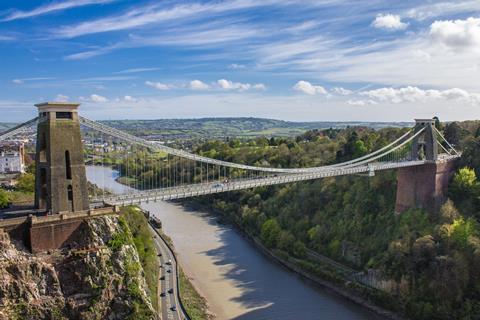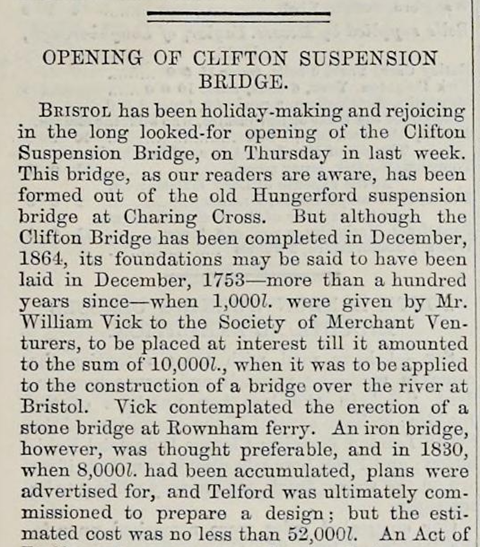The Builder reports on the opening of Brunel鈥檚 historic bridge, which was finally completed more than a century after plans were first laid.

In December 1864, and nearly 35 years after construction had started, the world鈥檚 longest chain bridge opened in Bristol. The origins of Clifton Suspension Bridge went back even further, to 1753, when a local merchant left 拢1,000 in his will with instructions to build a bridge over the Avon Gorge when the money had grown to 拢10,000 through interest.

That took a while. In fact the fund still had not hit the threshold 80 years later, but the project started anyway in 1830 with the appointment of 24-year old Isambard Kingdom Brunel. He proposed the radical idea of building a single 214m span over the gorge, suspended entirely on chains.
The news piece below, which tells the story, describes Brunel as the 鈥渄aring rival鈥� to fellow engineer Thomas Telford, the latter having proposed a more conventional design built on stone pillars.
Construction was halted after four months when riots erupted in Bristol following a House of Lords vote against plans to give parliamentary representation to the city. Financial problems dogged the project from the start, and all work had stopped by 1853.
Seven years later, The Builder reported that a new plan for completing the bridge had been 鈥渢aken up with spirit鈥�, and in the summer of 1860 a newly created Clifton Bridge Company purchased the chains and materials from another Brunel crossing, the Hungerford Bridge in London, which was being demolished.
Another four years later, the Bristol bridge finally opened, although Brunel did not live to see its completion. He had died in 1859 at the age of 53 and, in 1868, was commemorated in Westminster Abbey with a memorial window designed by the eminent architect Norman Shaw.
OPENING OF CLIFTON SUSPENSION BRIDGE
好色先生TV item in The Builder, 17 December, 1864
Bristol has been holiday-making and rejoicing in the long looked-for opening of the Clifton Suspension Bridge, on Thursday in last week. This bridge, as our readers are aware, has been formed out of the old Hungerford suspension bridge at Charing Cross.
But although the Clifton Bridge has been completed in December, 1864, its foundations may be said to have been laid in December, 1753 鈥� more than a hundred years since when 1,000 pounds were given by Mr William Vick to the Society of Merchant Venturers, to be placed at interest till it amounted to the sum of 10,000 pounds, when it was to be applied to the construction of a bridge over the river at Bristol.
Vick contemplated the erection of a stone bridge at Rownham ferry. An iron bridge, however, was thought preferable, and in 1830, when 8,000 pounds had been accumulated, plans were advertised for, and Telford was ultimately commissioned to prepare a design; but the estimated cost was no less than 52,000 pounds.
An Act of Parliament was got, and new designs were obtained from Brunel, Telford and other engineers; but still something like 50,000 pounds seemed to be requisite. Mr Davies Gilbert gave his advice, and Brunel鈥檚 plan was agreed upon. Telford would have had the bridge supported on gigantic columns, reared at great trouble; but his more daring rival determined to make the cliff鈥檚 support the structure, and he estimated the entire cost of the construction at 57,000 pounds.

Fortified with their design, which was satisfactory to the majority of the inhabitants of the city and neighbourhood, the trustees, in 1831, determined to commence the all-important undertaking, the Society of Merchant Venturers having given the land necessary on the Clifton side of the river, and Mr PJ Miles the stone from the quarry at Leigh necessary for constructing the pier at that side of the river.
The first stone was excavated, but the Bristol riots put the arrangement out of joint, and little was done till 1835, when wire was in the ascendant as the projected material of the bridge, and 35,000 pounds the estimated cost. Mr Brunel then modified his scheme, but the Bristolians were not satisfied.
Still the preliminary works were in progress; a wire was stretched across the river; and the foundation of the Somerset-shire buttress was laid when the British Association visited Bristol.
In 1837 the contractors became bankrupt, but in 1840 the buttress was completed, and in 1843 the money was all spent, 45,000 pounds having been realised and disposed of in massive piers etc before one-half of the iron-work for the bridge, flooring, toll-house etc were executed, and 30,000 pounds more were requisite to finish the work.
In 1853 the works ceased, and the undertaking was for the time abandoned. For seven more years matters remained in status quo, when the idea of using up the Hungerford Suspension Bridge was entertained, after Lieutenant Colonel Serrell, CE, of the United States, had offered to complete the bridge with wire for 17,000 pounds.
It was in 1860 that Mr WH Barlow and Mr J. Hawkshaw were consulted, and gave a favourable opinion as to the use of the Hungerford materials; and it is from these materials the bridge over the cliffs has at last been completed.
The materials were purchased for 5,000 pounds. The total cost of the bridge has been nearly 100,000 pounds. The bridge is 30ft wide, the iron-work weighs 500 tons, and the bridge has a span of 703ft, the largest of any chain-bridge in the world.
The engineers who have completed the bridge, though it may be said to have been designed so many years ago by Mr Brunel, are Messrs J Hawkshaw and WH Barlow, the resident engineer being Mr T Airey.
When viewed from the river, or from Clifton Down, the chains are more like threads than the substantial supports of a bridge on which it is estimated 8,000 persons might stand without the slightest danger to the structure.
More from the archives:
>> The clearance of London鈥檚 worst slum, 1843-46
>> The construction of the Palace of Westminster, 1847
>> Benjamin Disraeli鈥檚 proposal to hang architects, 1847
>> The Crystal Palace鈥檚 leaking roof, 1851
>> Setbacks on the world鈥檚 first underground railway, 1860
>> Alternative designs for Manchester Town Hall, 1868
>> The demolition of Northumberland House, 1874























No comments yet